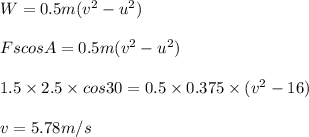
Physics, 21.06.2021 14:00 alexanderatiencia
A particle of mass m=375 g is launched with velocity of A =4 moves with a length AB=2.5m under the action of tractive force F=3.46 N making an angle 30. during its motion between A and B which is subjected to a frictional force f=1.5 N calculate V of B by applying the kinetic energy theorem

Answers: 1


Other questions on the subject: Physics

Physics, 21.06.2019 18:00, calmicaela12s
Which surface feature of the moon is characterized by mountainous areas? terrae craters maria regolith
Answers: 1

Physics, 22.06.2019 05:50, kamrulh278
Acylinder with a movable piston contains 11.7 moles of a monatomic ideal gas at a pressure of 1.32×10^5 pa. the gas is initially at a temperature of 300 k. an electric heater adds 43200 j of energy into the gas while the piston moves in such a way that the pressure remains constant. cp=20.79 j k^−1 mol^−1 for a monatomic ideal gas, and that the number of gas molecules is equal to avogadro's number (6.022×10^23) times the number of moles of the gas. (a) what is the temperature of the gas after the energy is added? (b) what is the change in volume of the gas? (c) how much work is done by the gas during this process?
Answers: 3

Physics, 22.06.2019 08:40, Hazeleyes13
An isolated conducting spherical shell carries a positive charge. part a which statement (or statements) about the electric field and the electric potential inside and outside the spherical shell is correct? which statement (or statements) about the electric field and the electric potential inside and outside the spherical shell is correct? electric potential inside the shell is constant and outside the shell is changing as 1/r2 both the electric potential and the electric field does change with r inside and outside the spherical shell electric potential inside and outside the shell is constant, but not zero electric potential inside the shell is constant and outside the shell is equal to zero electric field inside and outside the shell is constant (does not change with the position r), but is not equal to zero electric field inside and outside the shell is changing as 1/r (where r is the distance from the center of the sphere) electric field inside is equal to zero and outside the shell is constant, but not zero electric potential inside the shell is constant and outside the shell is changing as 1/r electric field inside and outside the shell is changing as 1/r2 electric field inside is equal to zero and outside the shell is changing as 1/r2 electric field inside and outside the shell is zero electric field inside is constant and outside the shell is changing as 1/r
Answers: 3

Physics, 22.06.2019 09:00, rhettperkins
One form of energy can be another type of energy. a. created to form b. transformed into c. destroyed and then created to form
Answers: 1
You know the right answer?
A particle of mass m=375 g is launched with velocity of A =4 moves with a length AB=2.5m under the a...
Questions in other subjects:














